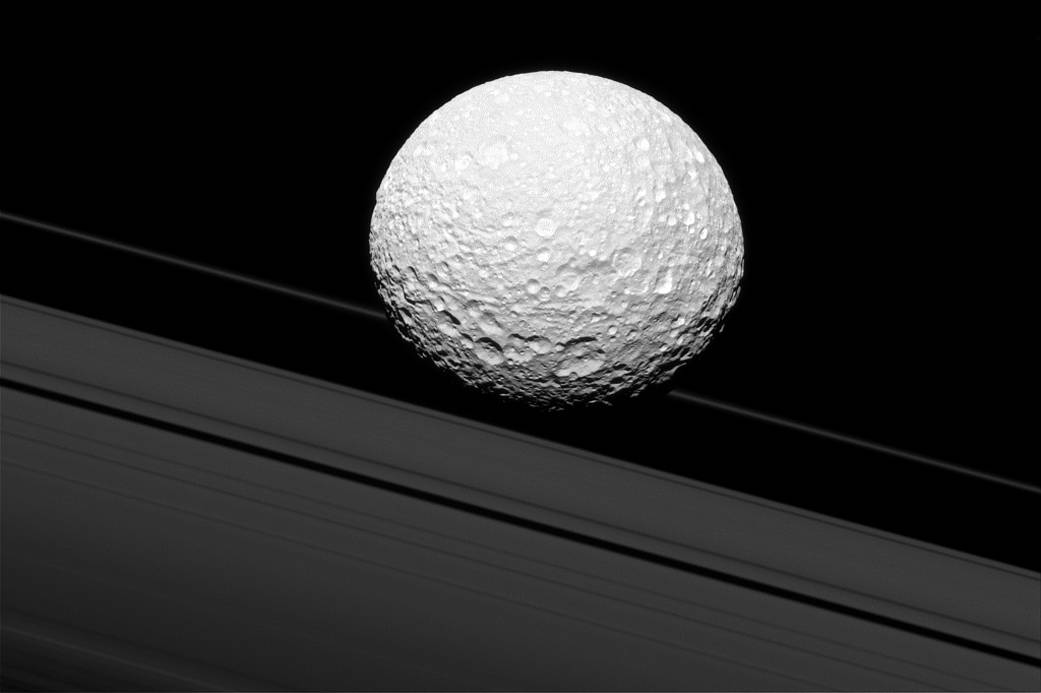
An analysis of previous data has confirmed that Mimas, Saturn's scarred moon reminiscent of the Death Star in Star Wars, hides an entire ocean beneath its icy surface.
With a diameter of only 400 kilometers and a mass 2,000 times less than the Moon, Little Mimas thus becomes the fifth satellite in the solar system on which there are clear indications of the existence of subsurface oceans.
The study was published in the magazine nature It suggests that large amounts of liquid water – the essential ingredient for life – may even be hidden in the icy regions of the solar system, such as on the moons of the planet Uranus.
One of Mima's most distinctive landmarks is the giant Herschel crater, which is 140 kilometers across. (NASA-JPL/Caltech)
Mimas, one of Saturn's ten moons, is named after one of the giants of Greek mythology.
It is completely covered by a thick layer of water ice, which has turned black over billions of years from chemical processes and asteroid impacts.
The new study estimates that the subsurface ocean lies buried 20 to 30 kilometers deep and occupies half of Mima's total volume, even though it represents only 1.3% of Earth's water.
“On the face of it, it is the most likely place in the solar system to find liquid water,” he commented. Reuters Valerie Linyi of the Paris Observatory, first author of the study.
“It looks old and inactive, with a huge hole. [Εξωτερικά] He added: “Nothing indicates the presence of the ocean.”
Hot in the deep
His study was based on observations of NASA's Cassini mission, which arrived in the Saturn system in 2004 and spent 13 years studying the planet and its moons.
But how is the existence of liquid water documented?
Where does the heat that keeps water liquid come from at a great distance from the sun?
First, data analysis shows that Mima's spin axis oscillates like a vortex with an asymmetric weight distribution, as expected from a body containing a liquid. Second, MEMA's orbit around Saturn changes with time.
The researchers say that these movements cannot be simulated on a computer without an underground ocean.
Little Mimas, top right, passes in front of Saturn in this stunning Cassini image (NASA/JPL-Caltech)
The heat that keeps water in a liquid state comes from frictional forces located deep within the mima. The satellite, which always faces the same side as Jupiter, follows an elliptical orbit, meaning its distance from Saturn is constantly changing.
This periodically affects the gravitational force that Mimas receives from Saturn and other moons approaching its path.
“This causes a periodic deformation of the interior of the MIMA, and part of the energy of the deformations is converted into heat,” explained Gabriel Tobey from the University of Nantes, a member of the research team.
Although Mimas has water and an internal heat source, the likelihood of it harboring microbial life is probably non-existent, as the study estimates that the ocean formed due to recent orbital changes, about 5 to 25 million years ago.
Much older, billions of years old, is the subsurface ocean of Enceladus, a moon larger than Saturn's, where jets have been discovered shooting water hundreds of kilometers high.
Subterranean oceans are also thought to exist on Saturn's Titan, and on Mars' Europa and Ganymede.
The latest study leaves open the possibility of latent oceans on many moons of the distant sky.

“Avid problem solver. Extreme social media junkie. Beer buff. Coffee guru. Internet geek. Travel ninja.”





More Stories
Artificial Intelligence: “Lies, Theft, and Cheating,” MIT warns
GTA 6: New release window for Rockstar Games’ coveted game
Katerina Kenorghiu: What was it like before plastic surgery